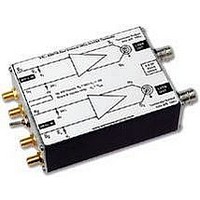APPLICATIONS
FEATURES
DESCRIPTION
The PRL-426 is a series of NECL-, PECL- or TTL-to-LVDS Logic Level Translators:
The PRL-426N/426P can receive either single-ended or differential input signals, selected by a switch. The input connectors on the
PRL-426N/426P are SMA. On the PRL-426T, the input is single-ended only, and the switch controls the input threshold (1.5 V or
1.0 V into 50 Ω). The input connectors on the PRL-426T are BNC.
The differential outputs are 50 Ω back-terminated and are designed for driving floating 100 Ω loads, normally the configuration used
in LVDS input circuits. The output swing is typically 600 mV with a common mode voltage of 1.2 V. The PRL-426NTR, PRL-
426PTR, and PRL-426TTR have Triax output connectors instead of the SMA connectors. These high speed translators facilitate
testing of high speed digital communications circuits where conversion of NECL/PECL clock and data signals to LVDS level
signals is often required.
The PRL-426N is designed to interface with -5.2 V or -3.3 V NECL circuits and the PRL-426P with +5 V PECL circuits. In the
differential input mode, both inputs D and D of the PRL-426N are terminated into 50 Ω/-2 V, and those of the PRL-426P into
50 Ω/3 V. In this mode, either one or both inputs can accept AC coupled signals as well. In the single input mode, signals should be
connected to the D inputs only. The D inputs are switched internally to V
PRL-426P, and termination resistors R
TTL circuits. In cases where the signal source cannot drive TTL voltages into 50 Ω, the input threshold switch can be used to change
the triggering voltage to 1.0 V.
Each unit is supplied with a ±8.5 V/1.4 A AC/DC Adapter and housed in a 1.3 x 2.9 x 3.9-in. extruded aluminum enclosure.
Available accessories include voltage distribution modules and brackets for mounting multiple units
•
•
•
•
•
•
•
•
•
•
•
•
PRL-426N DUAL CHANNEL NECL TO LVDS TRANSLATOR
•
•
•
PRL-426P DUAL CHANNEL PECL TO LVDS TRANSLATOR
PRL-426T DUAL CHANNEL TTL TO LVDS TRANSLATOR
Converting Single Ended or Differential NECL/PECL
Signals to LVDS Signals
Converting TTL Signals to LVDS
High Speed Digital Communications systems Testing
High Speed SONET Clock Level Translation
f max > 500 MHz for NECL/PECL inputs, 300 MHz for TTL
input
1.1ns Typical Output Rise & Fall Times
Single Ended or Differential 50 Ω/V
Switchable 1.5 V/1.0 V input threshold (TTL)
Complementary 50 Ω LVDS Outputs
SMA I/O Connectors for NECL/PECL; BNC Inputs for TTL
Triax Output connectors for PRL-426NTR, PRL-426PTR
and PRL-426TTR
Self-contained 1.3 x 2.9 x 3.9-in. units include ±8.5V/1.4A
AC/DC Adapters
PRL-426N converts NECL to LVDS
PRL-426P converts PECL to LVDS
PRL-426T converts TTL to LVDS.
T
's for the D input channels are changed to 62 Ω.The PRL-426T is designed to interface with
TT
Inputs (NECL/PECL)
BB
, nominally -1.3 V for the PRL-426N and 3.7 V for the
PRL-426NTR, NECL to LVDS (Triax) Translator
1234 Francisco Street, Torrance, CA 90502
Tel: 310-515-5330 Fax: 310-515-0068
Email:
sales@pulseresearchlab.com
www.pulseresearchlab.com
















